 THE ABOLITIONIST
MOVEMENT
THE ABOLITIONIST
MOVEMENT
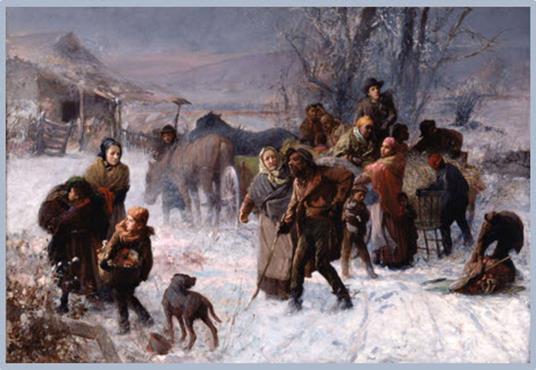
The Underground
Railroad: Charles T. Webber, 1893
Unit
Overview
During
the first half of the 1850s, some northerners expressed concerns about the
quality of life in America. They worked
to improve education, the prison system, the treatment of the mentally ill and
problems related to the consumption of alcohol.
The nation’s most controversial reform movement, however, was the effort
to end slavery. Let’s see how it all
happened.
A
Better America
In
the early 1800s, the Second Great
Awakening, a religious movement, energized American Christians. It began on the frontier with camp meetings
called revivals. Dynamic preachers inspired their listeners to
improve the world along with their personal lives. The Second Great Awakening expanded church
membership, increased the number of missionaries and encouraged an interest in
social reform. You can see the growth of
churches for each denomination pictured in the graphic below.
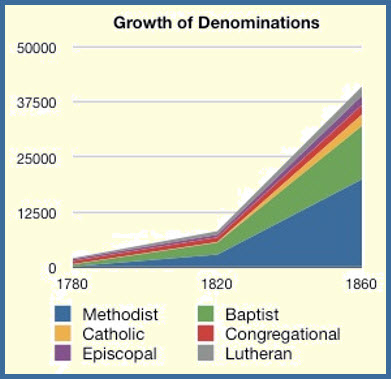
One
problem that drew the attention of nineteenth reformers was the abuse of
alcohol. They claimed that it was
responsible for crime, insanity, poverty and the breakup of families. The demands for temperance, or drinking little or no alcohol, gained momentum with
the formation of the American Society
for the Promotion of Temperance
in 1826. The group held rallies,
distributed pamphlets and delivered lectures concerning the negative effects of
alcohol consumption. Although some
states passed legislation to outlaw the manufacture and sale of alcoholic
beverages, many Americans disliked these laws.
Within a few years, most were canceled or repealed. However, the temperance movement reappeared
in the early 1900s and convinced Congress to propose a constitutional amendment
banning alcohol. Although the amendment
passed, it was overturned in 1933.
At
the same time, some northerners began working to improve public education and
campaigned for schools supported by tax dollars. The leader of the educational reform movement
was Horace Mann, a Massachusetts
lawyer. He became the head of the
Massachusetts Board of Education in 1837.
While he held this office, the board improved curriculum, lengthened the
school day and doubled teachers’ salaries.
Massachusetts also established a school for training teachers in
1839. Other states soon followed Mann’s
example. By 1860, free public elementary
schools were common in all northern states and several southern cities. On the other hand, public high schools were
rare, but the number of colleges and universities grew rapidly. Although most colleges admitted only men, Mount Holyoke became the first
permanent women’s college in 1837. In
Ohio, Oberlin College, founded in
1833, was open to men, women and free African Americans.
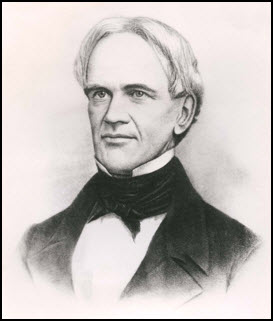
Horace Mann
Concerned
citizens also questioned the living conditions of prisoners and the mentally
ill. Several northern state legislatures
passed laws to assist criminals with their return to society. For example, prisoners
learned trades that would help them to find employment upon their release from
jail. Young offenders were separated
from hardened criminals, and architects designed jails with individual
cells. In some instances, inmates were
not guilty of any crime but were mentally ill.
Dorothea Dix, a Boston
teacher, made it her life’s work to bring this issue to the attention of the
American public. Traveling extensively
throughout the North and the South, she visited prisons and documented the
condition of the insane. She presented
these findings to several state legislatures to secure funds for hospitals and
treatment of the mentally disabled.
![]() Go to
Questions 1 through 5.
Go to
Questions 1 through 5.
The
Question of Slavery
Improving
education and providing appropriate care for the mentally ill were not the only
reform movements that swept the country during the early 1830s. Motivated by the Second Great Awakening and
American ideals, groups of reformers worked to end slavery and to extend the
rights of citizenship to African Americans.
This was not a new idea. Some
Americans had tried to limit or ban slavery before the American Revolution, and
delegates at the Constitutional Convention had debated the issue. Although the practice continued in the South,
most northern states outlawed slavery by the early 1800s. When the British outlawed enslavement
throughout their empire in 1832, American interest in the issue grew.
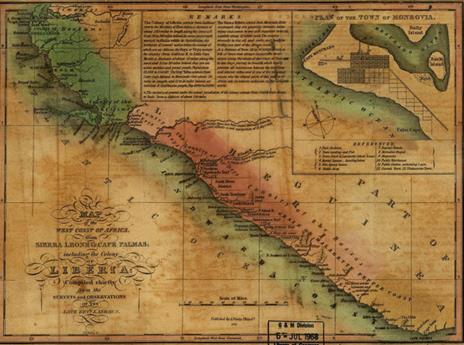
Map of Liberia:
1830
At
first, the antislavery movement focused on resettling African Americans rather
than securing their freedom within the United States. In 1816, the American Colonization Society,
composed of several white Virginians, bought slaves for the purpose of freeing
them and planned to send them out of the country. The organization raised money and purchased
land in West Africa for a colony. By
1822, African Americans arrived to settle in what was called Liberia. Even though Liberia became an independent
country in 1847, it did not attract large numbers of black colonists from
America, and it did not discourage the growth of slavery within the United
States. African Americans, whose
families had lived in the U.S. for several generations, did not want to go to
Africa. They wanted to live as free
people in America.
Other
antislavery reformers in the North concentrated their efforts on convincing
southerners to give up their slaves voluntarily. They suggested that slaves should be freed
gradually to avoid any major disruptions in the economy. Some congressmen considered asking the
federal government to pay owners for the loss of their slaves. This approach, referred to as gradualism, won very little support.
![]() Go to Questions 6 and 7.
Go to Questions 6 and 7.
The
Abolitionists
In
the 1830s, the increased cultivation of cotton made planters in the Deep South
more dependent on slave labor, and the number of enslaved individuals continued
to grow. Reformers, therefore, accepted
that a gradual approach to ending slavery had little chance of success. They took a harder line and called for the
immediate end, or abolition, of
slavery. Americans who held this view
became known as abolitionists.
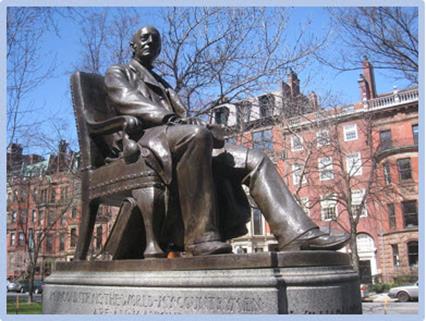
Statue of William Lloyd Garrison: Boston, Massachusetts
One
of the first white abolitionists to demand complete freedom for African
Americans was William Lloyd Garrison. Garrison left Massachusetts in 1829 to work
for an antislavery newspaper printed in Baltimore, Maryland. Because he believed this publication was too
willing to compromise on the slavery question, William Lloyd Garrison returned
to Boston two years later and founded the Liberator, his own antislavery
newspaper. The paper attracted a large
number of readers and led to the establishment of the New England Antislavery Society in 1832 along with the creation of
the American Antislavery Society in
1833. By 1840, over 1,000 chapters of
the American Antislavery Society appeared in towns and cities across the North.
For
free African Americans living in the North, the abolition of slavery was an
important goal. They were proud of their
freedom and wanted to help those who remained enslaved. African Americans took an active role in
organizing the American Antislavery Society and subscribed to the Liberator in large numbers. Following Garrison’s example, Samuel Cornish and John Russwurm
founded Freedom’s Journal, the first U.S. newspaper owned by African
Americans. In 1830, free
African-American leaders held a convention in Philadelphia and discussed ways to
help slaves emigrate from the Deep South.
Learn more about Garrison and other famous abolitionists by watching the
video listed below.
The
best-known African-American abolitionist was Frederick Douglass. Born in
Maryland as a slave, Douglass taught himself to read and write before escaping
to Massachusetts in 1838. Because he was
a runaway, he could have been legally captured and returned to Maryland. Nevertheless, Douglass joined the
Massachusetts Antislavery Society and became a powerful, popular speaker for
the organization’s cause. His
antislavery message reached even more people when he edited a newspaper called
the North
Star. Douglass not only spoke on
the evils of slavery in the United States, but he also delivered lectures in
Great Britain and the West Indies. He
became a free American in 1847 when he purchased his freedom from his former
owner.
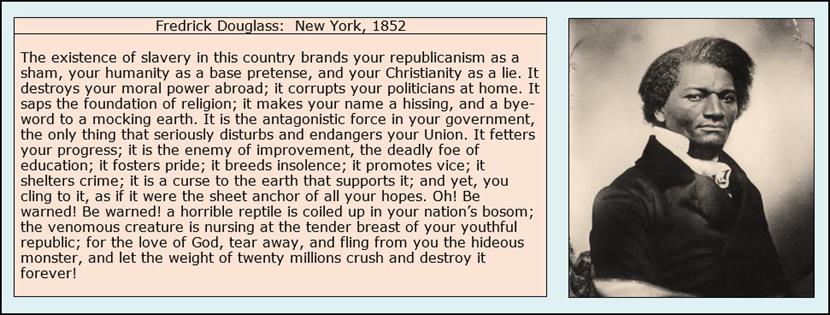
Although
the majority of white southerners defended slavery, a few joined the ranks of
the abolitionists. Among them were Sarah and Angelina Grimke. The sisters, born in South Carolina, were
members of a wealthy, influential family that owned slaves. After the death of their father, they
persuaded their mother to give them their share of the family inheritance. Normally, this consisted of cash or
land. The two women, however, asked for
several slaves whom they, in turn, immediately freed. As expected, they were severely criticized in
their community for this action. Sarah
and Angelina Grimke decided that they could do more for the cause if they moved
to the North so they settled in Philadelphia in 1832. With her husband, Theodore Weld, Angelina published Slavery as It Is, a
collection of first-hand descriptions of life under slavery. It became one of the most influential
abolitionist works of the era. Both
sisters were frequently invited to deliver lectures at antislavery society
meetings. Read an excerpt from one of
these speeches quoted in the graphic below.
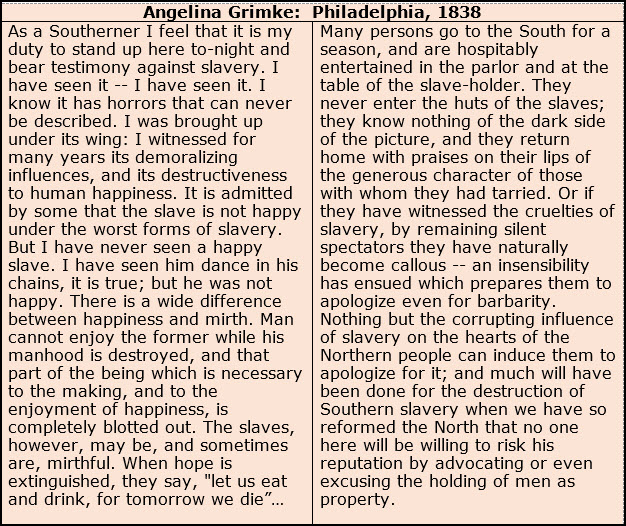
Those
who escaped slavery were often invited to describe their experiences. They gave powerful testimonies about their
lives as enslaved workers. One popular
witness was a women named Sojourner
Truth. She was born a slave in rural
New York in 1797 and given the name Isabella Baumfree. In 1826, Belle escaped, changed her name and
settled in New York City. She worked for
the abolition of slavery and for women’s rights. Part of one of her speeches is quoted in the graphic
below. Making a break for freedom was no
easy task for African Americans living in the South. A few managed to get away to Florida, Mexico
or the Caribbean Islands. Most, however,
dreamed of going north by way of the Underground Railroad.
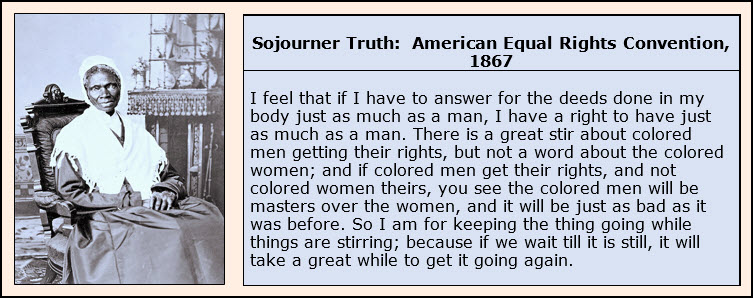
 Go to Questions 8 through 16.
Go to Questions 8 through 16.
The
The
Underground Railroad
Some
abolitionists believed that speaking out against slavery was not enough and
were determined to help African Americans gain their freedom. With this in mind, they established a network
of escape routes between the South and the North. This became known as the Underground Railroad. As you
learned in a previous unit, the Underground Railroad was not underground and
was not an actual railroad. Runaway
slaves, most of whom had never gone more than a few miles from their owner’s
land, traveled on foot at night and relied on the North Star as their
guide. They rested during the day in a
series of barns, church basements and safe houses, referred to as stations. Both black and white abolitionists served as conductors and guided the runaways to
their next destination. They also
provided food and clothing. Some slaves
who made this journey decided to settle in the North, but most hoped to cross
the border into Canada.
The
Underground Railroad was a dangerous activity for everyone involved. The abolitionists broke the law when they
harbored runaway slaves. At the same
time, professional catchers, who were paid to return slaves to their owners,
were a constant threat. Capture resulted
in severe punishment for a slave forced to return to the South. In reality, only a small number of African
Americans successfully escaped through the Underground Railroad, but it
provided hope for millions.
![]() Go to Questions 17 and 18.
Go to Questions 17 and 18.
The
Abolitionists Meet the Opposition
Abolitionist
societies in the North continued to grow, but their members represented only a
small segment of the population. In
fact, most northerners did not support the antislavery movement. They viewed the abolitionists as radicals and
feared their antislavery stance would remove all hope of compromise. Northern industrialists worried that the
national economy would suffer as a result.
Factory workers also resented the abolitionists because they believed
that an influx of freed slaves would lower wages. Others argued that, if freed, African
Americans would never blend into American society.
Strong
opposition to the abolitionist movement resulted in violent attacks in a number
of northern cities. A mob burned
Philadelphia’s antislavery headquarters to the ground, and William Lloyd
Garrison had to be rescued in Boston from a hostile crowd that was prepared to
hang him. In Illinois, Elijah Lovejoy’s abolitionist newspaper
office was raided on three separate occasions.
Each time Lovejoy replaced his ruined presses. In a fourth attack, a mob set fire to the
building and killed Lovejoy.
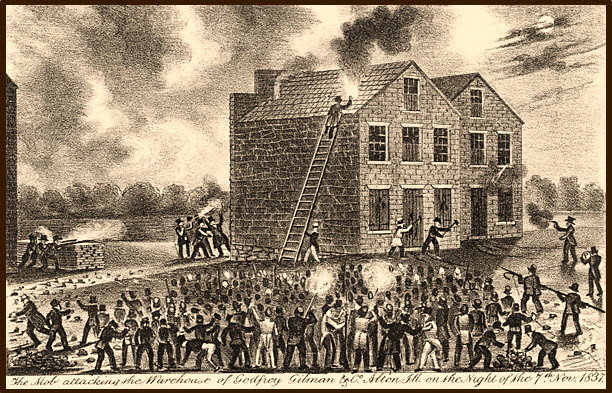
A Mob Attacking Lovejoy's Business
The
abolitionists also drew an angry response from southerners. They insisted that slavery was essential, not
only to the economy of the South but to the financial stability of the nation
as a whole. Slave owners argued that
they treated their slaves much better than northern manufacturers treated their
workers. Planters provided housing,
clothing, medical care and food for their slaves, but factory employees paid
for these necessities out of their own low earnings. Read an example of this line of reasoning
quoted in the graphic below. Southern
anger increased when northern abolitionist groups began to use the U.S. mail to
send antislavery pamphlets to the South.
Mail sacks suspected of containing this type of literature were burned
when they reached post offices in the South.
Most southerners, even if they did not own slaves, remained united
against the abolitionist cause.
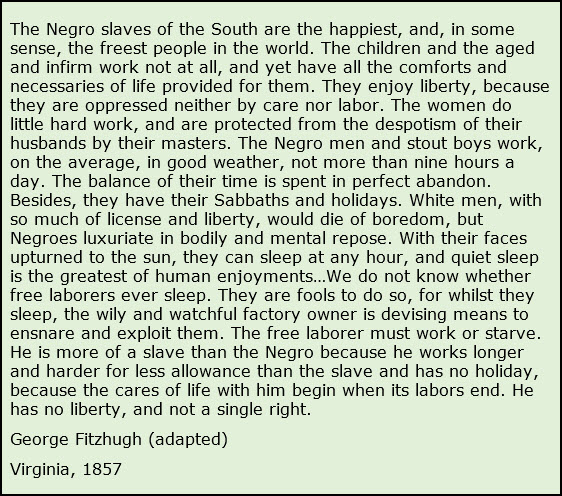
 Go to Questions 19 through 22.
Go to Questions 19 through 22.
What
Happened Next?
Even
though politicians made an effort to keep the Union together through
compromise, tension mounted between the North and the South throughout the
1850s. The focus of the controversy
shifted to the Great Plains where the Kansas Territory became a battleground
for slavery and antislavery forces.
Southerners connected the violence to the abolitionists and resented the
refusal of some northerners to comply with the Fugitive Slave Law. Before examining the impact of these events
in the next unit, review the names and terms found in Unit 31; then, complete
Questions 23 through 32.
![]() Go to Questions 23 through 32.
Go to Questions 23 through 32.
 |
| Unit 31 Frederick Douglass |
| Unit 31 Primary Sources: Conductor on the Underground Railroad Part Two Article and Quiz |
| Unit 31 What's the Big Idea? Worksheet |